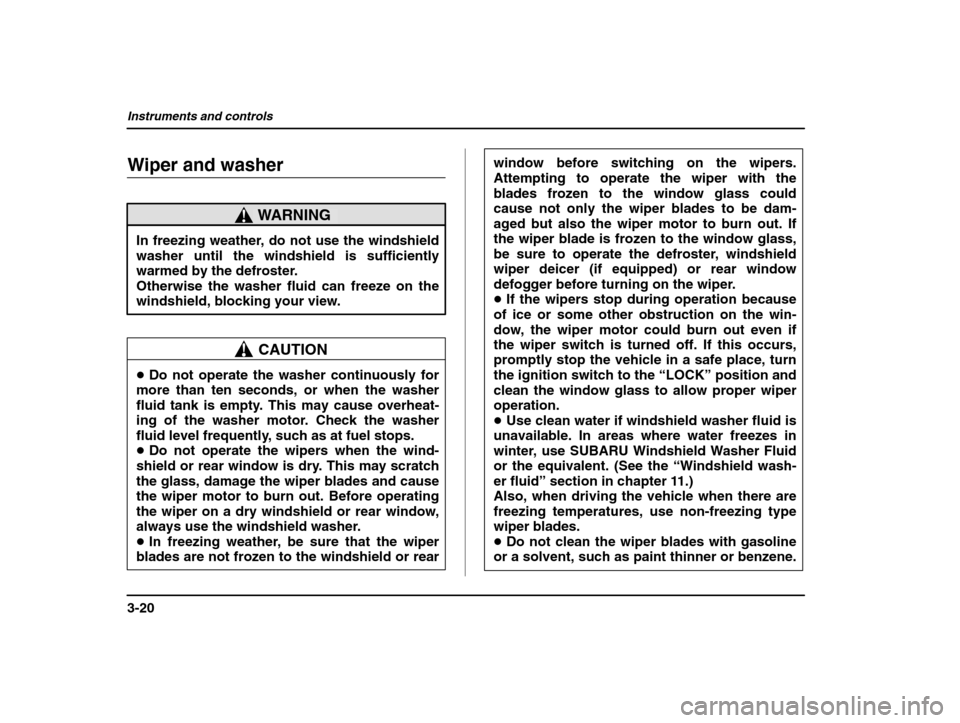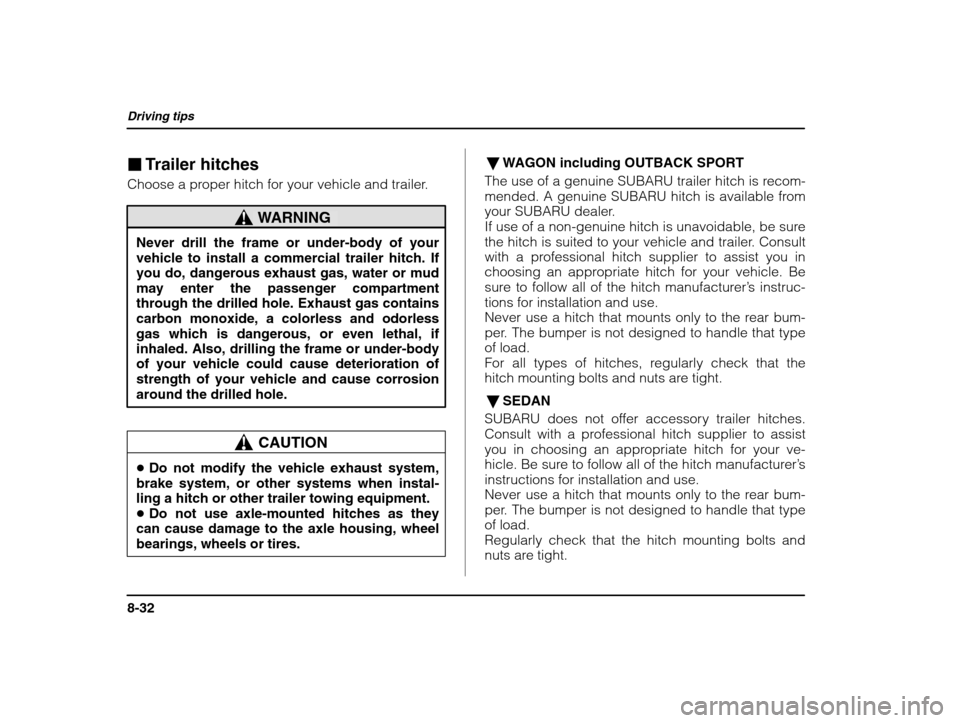Page 63 of 390

Seat, seatbelt and SRS airbags
1-40
strained at all times in a child restraint device or in a seatbelt, whichever is appropriate forthe child’s age, height and weight.
Secure ALL types of child restraint devices
(including forward facing child seats) in the
REAR seats at all times.
According to accident statistics, children are
safer when properly restrained in the rearseating positions than in the front seatingpositions.For instructions and precautions concerningthe child restraint system, see the “Child re-
straint systems ” section in this chapter.
� NEVER INSTALL A REARWARD FACING
CHILD SEAT IN THE FRONT SEAT. DOING SO
RISKS SERIOUS INJURY OR DEATH TO THE
CHILD BY PLACING THE CHILD ’S HEAD TOO
CLOSE TO THE SRS AIRBAG. � Never allow a child to stand up, or to kneel
on the front passenger ’s seat, or never hold a
child on your lap or in your arms. The SRS air- bag deploys with considerable force and caninjure or even kill the child.CAUTION
� When the SRS airbag deploys, some smoke
will be released. This smoke could cause breathing problems for people with a history of asthma or other breathing trouble. If you oryour passengers have breathing problems af-
ter SRS airbag deploys, get fresh air promptly.� A deploying SRS airbag releases hot gas.
Occupants could get burnt if they come into direct contact with the hot gas.
NOTE When you sell your vehicle, we urge you to ex- plain to the buyer that it is equipped with SRS
airbags by alerting him to the applicable sectionin this owner ’s manual.
Page 133 of 390

Instruments and controls
3-20
Wiper and washer
WARNING
In freezing weather, do not use the windshield
washer until the windshield is sufficiently
warmed by the defroster.Otherwise the washer fluid can freeze on the
windshield, blocking your view.
CAUTION
�Do not operate the washer continuously for
more than ten seconds, or when the washer
fluid tank is empty. This may cause overheat-
ing of the washer motor. Check the washer
fluid level frequently, such as at fuel stops. � Do not operate the wipers when the wind-
shield or rear window is dry. This may scratchthe glass, damage the wiper blades and causethe wiper motor to burn out. Before operating
the wiper on a dry windshield or rear window,
always use the windshield washer. � In freezing weather, be sure that the wiper
blades are not frozen to the windshield or rear window before switching on the wipers.Attempting to operate the wiper with the
blades frozen to the window glass could
cause not only the wiper blades to be dam-aged but also the wiper motor to burn out. Ifthe wiper blade is frozen to the window glass,
be sure to operate the defroster, windshield wiper deicer (if equipped) or rear window
defogger before turning on the wiper.�
If the wipers stop during operation because
of ice or some other obstruction on the win-
dow, the wiper motor could burn out even if the wiper switch is turned off. If this occurs, promptly stop the vehicle in a safe place, turnthe ignition switch to the “LOCK” position and
clean the window glass to allow proper wiperoperation.� Use clean water if windshield washer fluid is
unavailable. In areas where water freezes in
winter, use SUBARU Windshield Washer Fluidor the equivalent. (See the “Windshield wash-
er fluid ” section in chapter 11.)
Also, when driving the vehicle when there are
freezing temperatures, use non-freezing type wiper blades. � Do not clean the wiper blades with gasoline
or a solvent, such as paint thinner or benzene.
Page 263 of 390

Driving tips
8-32
�Trailer hitches
Choose a proper hitch for your vehicle and trailer.
WARNING
Never drill the frame or under-body of your
vehicle to install a commercial trailer hitch. If you do, dangerous exhaust gas, water or mud may enter the passenger compartment
through the drilled hole. Exhaust gas containscarbon monoxide, a colorless and odorless
gas which is dangerous, or even lethal, if
inhaled. Also, drilling the frame or under-body of your vehicle could cause deterioration of strength of your vehicle and cause corrosionaround the drilled hole.
CAUTION
� Do not modify the vehicle exhaust system,
brake system, or other systems when instal- ling a hitch or other trailer towing equipment.� Do not use axle-mounted hitches as they
can cause damage to the axle housing, wheelbearings, wheels or tires. �
WAGON including OUTBACK SPORT
The use of a genuine SUBARU trailer hitch is recom-
mended. A genuine SUBARU hitch is available from
your SUBARU dealer.
If use of a non-genuine hitch is unavoidable, be sure
the hitch is suited to your vehicle and trailer. Consult
with a professional hitch supplier to assist you in
choosing an appropriate hitch for your vehicle. Be
sure to follow all of the hitch manufacturer ’s instruc-
tions for installation and use.
Never use a hitch that mounts only to the rear bum-
per. The bumper is not designed to handle that typeof load.
For all types of hitches, regularly check that the
hitch mounting bolts and nuts are tight.
� SEDAN
SUBARU does not offer accessory trailer hitches.
Consult with a professional hitch supplier to assist
you in choosing an appropriate hitch for your ve-
hicle. Be sure to follow all of the hitch manufacturer ’s
instructions for installation and use.
Never use a hitch that mounts only to the rear bum-
per. The bumper is not designed to handle that typeof load.Regularly check that the hitch mounting bolts and
nuts are tight.
Page 297 of 390

Appearance care
10-6
wear prematurely. Regular cleaning with a soft,
moist, natural fiber cloth should be performed
monthly, taking care not to soak the leather or allowwater to penetrate the stitched seams.A mild detergent suitable for cleaning woolen fab-
rics may be used to remove difficult dirt spots, rub-
bing with a soft, dry cloth afterwards to restore the
luster. If your SUBARU is to be parked for a long
time in bright sunlight, it is recommended that the
seats and headrests be covered, or the windows
shaded, to prevent fading or shrinkage.
Minor surface blemishes or bald patches may be
treated with a commercial leather spray lacquer. You will discover that each leather seat section will de-
velop soft folds or wrinkles, which is characteristic of
genuine leather. �Synthetic leather upholstery
The synthetic leather material used on the SUBARU may be cleaned using mild soap or detergent and
water, after first vacuuming or brushing away loose
dirt. Allow the soap to soak in for a few minutes and
wipe off with a clean, damp cloth. Commercial foam-type cleaners suitable for synthetic leather materials
may be used when necessary. NOTE Strong cleaning agents such as solvents, paint
thinners, window cleaner or gasoline must neverbe used on leather or synthetic interior materials.
Page 368 of 390
Specifications
12-3
– CONTINUED –
�Engine
Engine model
EJ251
(2.5-liter, SOHC, non-turbo)EJ205
(2.0-liter, DOHC, turbo)
Engine typeHorizontally opposed, liquid cooled 4 cylinder, 4-stroke gasoline engine
Displacement cu in. (cc)149.9 (2,457)121.7 (1,994)
Bore × Stroke in. (mm)3.92 × 3.11 (99.5 × 79.0)92.0 × 75.0 (3.62 × 2.95)
Compression ratio10.0 : 18.0 : 1
Firing order1 – 3 – 2 – 4
� Electrical system
Battery type
di tEurope modelMT12V-48AH (55D23L)and capacity (5HR)ATWith 2.5-liter engine12V-52AH (75D23L)(5HR)With 2.0-liter engine12V-52AH (65D23L)
Alternator2.5-liter engine12V – 75A
2.0-liter engine12V – 75A
Spark plugs2.5-liter engineBKR6E-11 (NGK)
BKR5E-11 (NGK)
RC10YC4 (Champion)
2.0-liter turbo enginePFR6G (NGK)
AT : Automatic transmission MT : Manual transmission